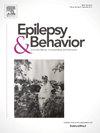与在工作场所披露癫痫相关的个人因素和关系因素。
IF 2.3
3区 医学
Q2 BEHAVIORAL SCIENCES
引用次数: 0
摘要
背景:在工作场所披露癫痫的决定是复杂的,因为它既有利也有弊。在这项研究中,我们旨在根据披露决策模型,为需要在癫痫监测室(EMU)接受综合评估的患者确定在工作场所披露癫痫的相关因素:这项回顾性研究共纳入了193名癫痫患者(男性112名,年龄18-66岁),他们在东北大学医院癫痫监测室接受了全面评估,包括长期视频脑电图监测、神经影像学研究以及神经心理学和社会心理评估。数据来源于病历和 EMU 的自我报告问卷。结果变量为是否患有癫痫。根据披露决策模型选择了预测变量:个人因素(即年龄、性别、癫痫发病年龄、癫痫发作频率、过去两年中全身强直阵挛发作或局灶至双侧强直阵挛发作、观看自己癫痫发作的经历以及感到耻辱)和关系因素(即遭受歧视的经历、形成的耻辱感和社会支持)。数据采用逻辑回归分析模型进行分析:结果表明,43.5% 的患者向其雇主披露了癫痫。与披露癫痫相关的因素是歧视经历(几率比[OR],7.78;95% 置信区间[CI],2.84-21.34,P):这项研究表明,披露癫痫的决定既与个人因素有关,如观看自己癫痫发作的经历,也与关系因素有关,如遭受歧视和被污名化的经历。本文章由计算机程序翻译,如有差异,请以英文原文为准。
Individual and relational factors related to disclosure of epilepsy in the workplace
Background
The decision to disclose epilepsy in the workplace is complex, as it entails both advantages and disadvantages. In this study, we aimed to identify the factors associated with disclosure of epilepsy in the workplace based on the disclosure decision-making model for patients who required underwent comprehensive assessment in the Epilepsy Monitoring Unit (EMU).
Methods
This retrospective study included 193 patients with epilepsy (112 men, aged 18–66 years) who underwent comprehensive assessment, including long-term video-EEG monitoring, neuroimaging studies, and neuropsychological and psychosocial assessment in the Tohoku University Hospital EMU. Data were obtained from the medical records and self-reported questionnaires at our EMU. The outcome variable was disclosure of epilepsy. Predictive variables were selected based on the disclosure decision-making model: individual factors (i.e., age, sex, age at onset of epilepsy, seizure frequency, generalized tonic-clonic seizures or focal to bilateral tonic-clonic seizures in the last 2 years, experiences of viewing own seizure, and felt stigma), and relational factors (i.e., experiences of discrimination, enacted stigma, and social support). Data were analyzed using a logistic regression analysis model.
Results
Our results indicated that 43.5% of patients disclosed epilepsy to their employer. The factors that associated with disclosure of epilepsy were experiences of discrimination (odds ratio [OR], 7.78; 95% confidence interval [CI], 2.84–21.34, p < 0.01), experiences of viewing own seizure (OR, 3.51; 95% CI, 1.27–9.72, p < 0.05), and level of enacted stigma (OR, 0.69; 95% CI, 0.48–0.99, p < 0.05).
Conclusion
This study indicated that the decision to disclose epilepsy was associated with both individual factors, such as experience of viewing own seizures, and relational factors, such as experience of discrimination and enacted stigma.
求助全文
通过发布文献求助,成功后即可免费获取论文全文。
去求助
来源期刊

Epilepsy & Behavior
医学-行为科学
CiteScore
5.40
自引率
15.40%
发文量
385
审稿时长
43 days
期刊介绍:
Epilepsy & Behavior is the fastest-growing international journal uniquely devoted to the rapid dissemination of the most current information available on the behavioral aspects of seizures and epilepsy.
Epilepsy & Behavior presents original peer-reviewed articles based on laboratory and clinical research. Topics are drawn from a variety of fields, including clinical neurology, neurosurgery, neuropsychiatry, neuropsychology, neurophysiology, neuropharmacology, and neuroimaging.
From September 2012 Epilepsy & Behavior stopped accepting Case Reports for publication in the journal. From this date authors who submit to Epilepsy & Behavior will be offered a transfer or asked to resubmit their Case Reports to its new sister journal, Epilepsy & Behavior Case Reports.
 求助内容:
求助内容: 应助结果提醒方式:
应助结果提醒方式:


